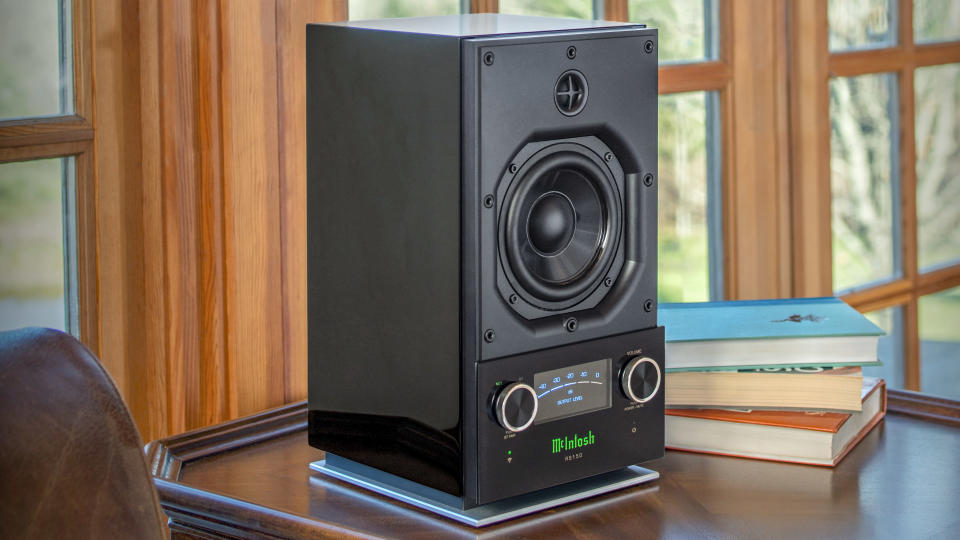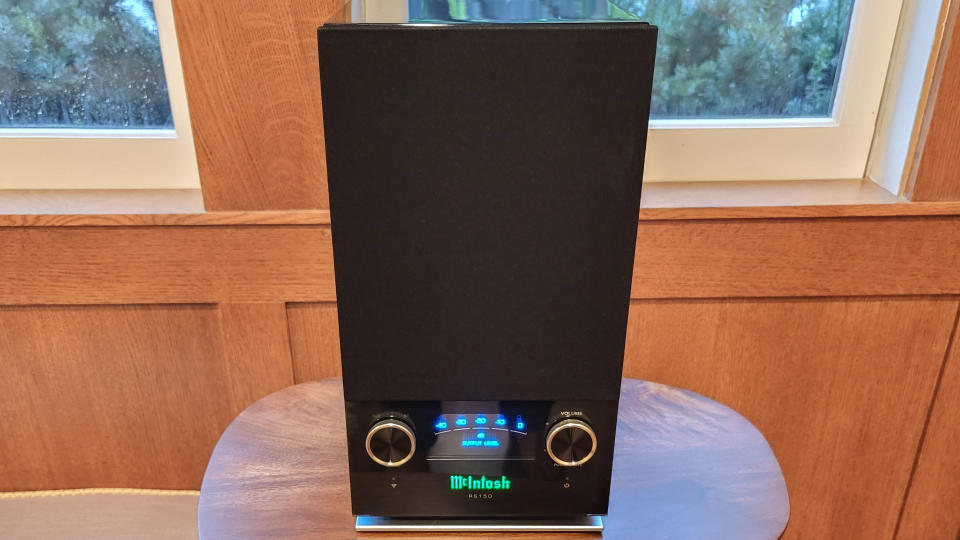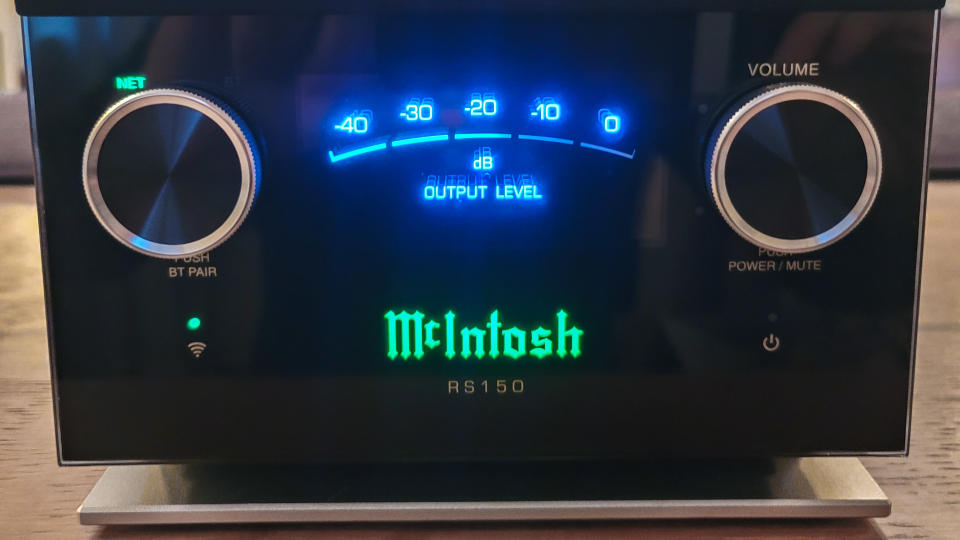I test audio gear for a living — and this $1,200 Bluetooth speaker just blew me away

With a long history as the amplifier of choice for artists and demanding listeners alike, I’ve lusted after McIntosh audio gear for years. In fact (full disclosure), I once bid $200 on a McIntosh MC-2300 600W amp used in the Grateful Dead’s “wall of sound” stage sound system. My jaw dropped when I saw that it went for over $25,000.
With that in mind, the McIntosh RS150 Wireless Loudspeaker looks like a bargain at $1,200. Much like our audio editor's roundup of the best wireless speakers for sound and style, the McIntosh shakes up traditional Hi-Fi conventions with a modern audio solution that puts as much emphasis on home style as it does on sound quality.
Although it’s twice the price of my current smartphone, it's a luxury that my strained budget could stretch to. It can be found for $1,200 at Crutchfield or alternatively check for local dealers on the McIntosh website. There’s also a special edition for deadheads with the “Steal Your Face” logo and dancing bears printed on the front. This Grateful Dead Limited Edition RS150 version is available for $1,500 direct from the McIntosh shop.
A beauty that's more than skin deep

After listening to it for hours and hours, I love the warmth that the RS150’s audio exudes.
Far from the regular designs found in our best Bluetooth speakers roundups with plastic cabinets, the RS150's gorgeous enclosure is made from MDF with a glossy black surface that resembles the hand-rubbed appearance of a Steinway piano. It looks superb with the RS150 black monolith fitting in with my kitchen's black granite counter, my TV room's light oak paneling and my office with cherry woodwork.
The speaker’s removable grille hides its 5.25 inch woofer and 0.75 inch fluid filled dome tweeter. The back has a rectangular tuned port to help extend authority at the lower frequency range down to 48Hz, while also allowing the speaker to breathe.
Inside, the RS150 speaker has a high-quality power supply. There are two Class D amplifiers that are rated to deliver up to 90W power output to the woofer and 30W to the tweeter.
Let there be light
Powered up, the company’s logo is lit up in green, but my eye was drawn to the RS150’s output meter that shows how hard the amp is working. Like older McIntosh designs, it’s lit in blue, but rather than a mechanical VU meter, it has a 3.5-inch LCD display that fills in a semicircular bar. It’s almost hypnotic to watch the meter respond to the music.
There are two black and chrome controls on the front. The right one adjusts the volume, pauses playback, and changes the bass response. There are mute and maximum volume LEDs, and the left knob controls the meter’s brightness and handles Bluetooth pairing. LEDs show a Bluetooth or Wi-Fi connection.
With its silver pedestal, the RS150 measures 14.5 x 7.6 x 7.8 inches. It's one-quarter the size of the JBL L75MS ($1,500) music system, which delivers wireless stereo sound via Bluetooth or Wi-Fi. The big difference is that the RS150 needs to be connected to a phone, tablet or computer to work. The L75MS has a built-in digital audio player to stream music directly.
Wireless wonder

A lot of this speaker's charm comes from its ability to connect with a wide assortment of wireless sources. Its digital encoder can handle up to 24-bit/192kHz audio when streamed over a Wi-Fi or Ethernet home network. There's also Apple AirPlay 2 and Google’s Chromecast support. Bluetooth 5.0 has aptX HD for up to 24-bit/48kHz audio support at 576kbps. Its surprisingly long 60-foot range means that I was able to listen in an adjacent room.
The McIntosh RS150 was without comparison in conveying rich mid-range tones.
The speaker works with Spotify Connect, Roon and Tidal Connect music services, and playback and volume control is taken care of within these apps. There's no dedicated control app for the RS150.
Sadly, the unit’s covered USB port is for a technician to run diagnostic software not for digital audio. It was frustrating to find that while the RS150 covers wireless well, it lacks wired RCA, coaxial or optical inputs. There isn’t even a headphone jack or a subwoofer output.
With so many wireless ways to use the RS150, it took me about 20 minutes to fully set up the speaker. I opened the RS150’s setup page by entering its IP address into a browser window and checked out the Overview page’s basic connection parameters followed by the Settings page. Next, I scanned for and connected with my Wi-Fi network and used Google’s Home app on my Samsung Galaxy Note 20 phone to connect. When the speaker made a trilling sound, it was online.
From my iPad Pro I played Jorma Kaukonen’s “Quah” album from Spotify using Apple’s AirPlay2 protocol. The setup was a little more involved and took a couple of minutes to work. Well worth the effort, the well-blended guitar riffs and vocals on “Sweet Hawaiian Sunshine” came through without diminishing the song’s energy and vibrancy.
Later, I used my Mac Mini to stream Frédéric Kooshmanian’s Zone Blanche instrumental tracks from the French TV show via Bluetooth. It paired quickly and filled the room with the music’s eerie, ethereal mood music. The plaintive banjo string plucking reproduced with extraordinary clarity and sharpness without sounding hollow or obscuring the beat of the kettle drums.
Crank it up
Cranking up the Stooges Brass Band’s “Wind it Up” to see what the RS150 was capable of at high volume, the speaker’s output meter was pushing -5dB with a vibrant and dynamic demonstration. Free of booming or bass rumbling, the intensity of the drums was complemented by the clean upper registers of the brass section with the slide trombone, raucous vocals and cow bell backbeat.
For some, anything les than the thrill of stereo sound will be a disappointment — although you can gang two RS150s together via Bluetooth, the output remains monoaural. The single speaker RS150 may not have the spacious open feeling I get from stereo or surround sound systems, but it was without comparison in conveying the rich mid-range tones that often get left behind. At full volume, it didn’t rattle the windows but was plenty to drown out a jackhammer from nearby driveway construction.
There was one snag, after a few days, the RS150’s Bluetooth connection intermittently stopped working. Restarting it didn’t help, and McIntosh replaced the unit under its three year warranty. The replacement unit worked fine.
The RS150 occupies a prominent place on my desk. After listening to it for hours and hours, I love the warmth that the RS150’s audio exudes. It’s not only one of the most beautiful wireless speakers I’ve seen, but one that delivers a great alternative to traditional stereo sound. For me, it sounds as good as it looks.
